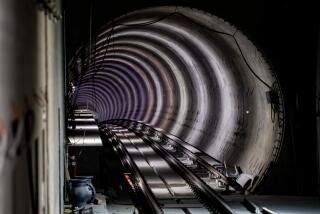Metrolink on the slow track to safer cars
Tight budgets at Southern California’s regional transportation agencies might scuttle a plan to speed up replacement of Metrolink’s aging passenger cars with a safer South Korean model that can better protect passengers and train crews during a crash.
John E. Fenton, the railroad’s safety-conscious chief executive, says he would like to move quickly to add 43 Hyundai Rotem passenger cars to Metrolink’s current contract to buy 117 cars for $230 million.
Rotem cars have energy-absorbing crush zones now required by the federal government, a safety improvement that Metrolink has urged since the deadly crash near Glendale five years ago that killed 11.
Trying to shed its record of major accidents -- the most recent being the Chatsworth crash two years ago that resulted in 25 deaths and 150 injuries -- the railroad is the first commuter line in the country to purchase the new model.
Twenty of the coaches can be bought for the discounted price of $1.8 million each by exercising a contract option that expires next month. The others are available at the regular price of $2.35 million each.
Though the 20-car option would cost $36 million and the 43-car plan $90 million, the five local transportation agencies that finance Metrolink -- two with annual budgets exceeding $1 billion -- might not be able to pay for any additional cars because of their own financial difficulties.
Consequently, about 20% of the line’s current 150-car fleet will remain older Bombardier coaches that are not equipped with the latest safety innovations.
“There’s no doubt these [Hyundai] cars represent the state-of-the art in safety technology, but funding is at a premium,” said Fenton, who replaced David Solow as the line’s chief executive in April. “Even with the contract option, agencies are very constrained right now.”
Metrolink is funded by transportation agencies in Los Angeles, Orange, Riverside, Ventura and San Bernardino counties. Because of the recession, the agencies are trying to adjust to lower transit ridership, the loss of state funding and steep declines in revenue from county sales taxes that help pay for transportation projects.
Also at Metrolink, the highest safety priority has been placed on equipping trains with a $200-million-plus automated collision avoidance system three years ahead of a federal deadline in 2015.
“We need to make sure all the numbers make sense. There are lots of questions we need to get answers to,” said Richard Katz, who sits on the Metrolink and Los Angeles County Metropolitan Transportation Authority boards. “I would love to have these cars. The sooner we can incorporate these into our fleet, the better off we will be.”
Bart Reed, executive director of the Transit Coalition, a nonprofit organization, said Fenton should be allowed to do what he was hired to do: improve safety and hold the line on costs, which the additional cars would help accomplish.
The 20-car option might save Metrolink almost $22 million because the railroad would not have to overhaul the older Bombardier cars that the new coaches would replace.
As a result, Metrolink would have to spend only $14 million by exercising the contract option.
“It may be penny-wise and pound-foolish to prevent this bold move,” Reed said. “Some of these [transit authorities] are multibillion-dollar agencies. They might not have the money at this moment, but they can re-prioritize their funding. When you can make the ride safer for passengers, it’s a no-brainer.”
Metrolink’s board is scheduled to discuss Fenton’s plans next week. If the railroad doesn’t pursue the additional cars, Fenton said, the line would take steps to protect its Bombardier cars by surrounding them on trains with the Rotem cars.
About 10 a month are now arriving for testing and evaluation. Those will be put into service around Thanksgiving and the rest by next summer.
“I am always going to remain optimistic and pursue every option until there is just no way to do it,” Fenton said. “If we don’t get these cars this time, maybe we can come back later. Perhaps when the economy gets better.”
--
More to Read
Sign up for Essential California
The most important California stories and recommendations in your inbox every morning.
You may occasionally receive promotional content from the Los Angeles Times.











